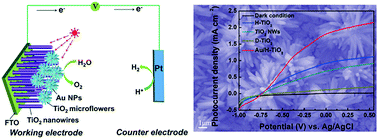当前位置:
X-MOL 学术
›
Catal. Sci. Technol.
›
论文详情
Our official English website, www.x-mol.net, welcomes your
feedback! (Note: you will need to create a separate account there.)
Hierarchical TiO2 nanowire/microflower photoanode modified with Au nanoparticles for efficient photoelectrochemical water splitting†
Catalysis Science & Technology ( IF 4.4 ) Pub Date : 2018-01-26 00:00:00 , DOI: 10.1039/c7cy02641b Yanyan Duan 1, 2, 3, 4, 5 , Shaochen Zhou 1, 2, 3, 4, 5 , Zhihong Chen 6, 7, 8 , Jianmin Luo 1, 2, 3, 4, 5 , Mei Zhang 1, 2, 3, 4, 5 , Fu Wang 1, 2, 3, 4, 5 , Tao Xu 9, 10, 11, 12 , Chuanyi Wang 1, 2, 3, 4, 5
Catalysis Science & Technology ( IF 4.4 ) Pub Date : 2018-01-26 00:00:00 , DOI: 10.1039/c7cy02641b Yanyan Duan 1, 2, 3, 4, 5 , Shaochen Zhou 1, 2, 3, 4, 5 , Zhihong Chen 6, 7, 8 , Jianmin Luo 1, 2, 3, 4, 5 , Mei Zhang 1, 2, 3, 4, 5 , Fu Wang 1, 2, 3, 4, 5 , Tao Xu 9, 10, 11, 12 , Chuanyi Wang 1, 2, 3, 4, 5
Affiliation

|
An efficient photoelectrochemical water splitting system is developed based on a hierarchical TiO2 nanowire/microflower (H-TiO2) photoanode, which is synthesized via a one-step hydrothermal process. The H-TiO2 structure is formed via three primary self-assembly processes and simultaneously offers excellent ultraviolet light absorption capacity and large specific surface area. The H-TiO2 photoanode achieves a 1.3 fold enhancement in photocurrent density compared to its TiO2 nanowire-based counterpart at 1.23 V vs. reversible hydrogen electrode (the theoretical potential for water electrolysis). More strikingly, by incorporating the surface plasmon resonance (SPR) effect from Au nanoparticles (NPs), the resulting Au/H-TiO2-based photoanodes (Au/H-TiO2) exhibit an about two-fold enhancement in photocurrent density under both simulated sunlight and visible-light illumination. Moreover, the maximum photoconversion efficiency of Au/H-TiO2 gives three fold enhancement compared to that in the absence of Au NPs. Significantly, Au NPs incorporated on the H-TiO2 surface also serve as co-catalysts like Pt under white-light illumination, reducing the onset potential by about 0.15 V and the current saturation potential by about 0.18 V. The enhanced photoactivity under white light is due to the co-action of electron transfer from the efficient carrier separation of H-TiO2 (ultraviolet part) and Au to H-TiO2 under the SPR effect (visible part). The present study provides a new strategy for designing and fabricating TiO2-based devices with favorable energy conversion efficiency for photoelectrochemical water splitting.
中文翻译:

Au纳米粒子修饰的 TiO 2纳米线/微花光阳极,用于有效的光电化学水分解†
基于分级的TiO 2纳米线/微光(H-TiO 2)光电阳极,开发了一种高效的光电化学水分解系统,该光电阳极是通过一步水热法合成的。H-TiO 2结构是通过三个主要的自组装过程形成的,同时具有出色的紫外线吸收能力和较大的比表面积。在1.23 V vs. H. TiO 2纳米线的基础上,H-TiO 2光电阳极的光电流密度提高了1.3倍。可逆氢电极(水电解的理论电位)。更惊人的是,通过并入Au纳米颗粒(NPs)的表面等离振子共振(SPR)效应,所得的Au / H-TiO 2基光阳极(Au / H-TiO 2)在光强下的光电流密度提高了约两倍。模拟日光和可见光照明。此外,与不存在Au NPs相比,Au / H-TiO 2的最大光转换效率提高了三倍。值得注意的是,Au NPs掺入了H-TiO 2中在白光照射下,表面也可以用作助催化剂,例如Pt,可将起始电势降低约0.15 V,将电流饱和电势降低约0.18V。白光下增强的光活性是由于来自H-TiO 2的高效率载体分离2(紫外线部分)和Au到H-的TiO 2下SPR效应(可见部分)。本研究提供了一种新的策略,用于设计和制造具有良好能量转换效率的TiO 2基器件,用于光电化学水分解。
更新日期:2018-01-26
中文翻译:

Au纳米粒子修饰的 TiO 2纳米线/微花光阳极,用于有效的光电化学水分解†
基于分级的TiO 2纳米线/微光(H-TiO 2)光电阳极,开发了一种高效的光电化学水分解系统,该光电阳极是通过一步水热法合成的。H-TiO 2结构是通过三个主要的自组装过程形成的,同时具有出色的紫外线吸收能力和较大的比表面积。在1.23 V vs. H. TiO 2纳米线的基础上,H-TiO 2光电阳极的光电流密度提高了1.3倍。可逆氢电极(水电解的理论电位)。更惊人的是,通过并入Au纳米颗粒(NPs)的表面等离振子共振(SPR)效应,所得的Au / H-TiO 2基光阳极(Au / H-TiO 2)在光强下的光电流密度提高了约两倍。模拟日光和可见光照明。此外,与不存在Au NPs相比,Au / H-TiO 2的最大光转换效率提高了三倍。值得注意的是,Au NPs掺入了H-TiO 2中在白光照射下,表面也可以用作助催化剂,例如Pt,可将起始电势降低约0.15 V,将电流饱和电势降低约0.18V。白光下增强的光活性是由于来自H-TiO 2的高效率载体分离2(紫外线部分)和Au到H-的TiO 2下SPR效应(可见部分)。本研究提供了一种新的策略,用于设计和制造具有良好能量转换效率的TiO 2基器件,用于光电化学水分解。











































 京公网安备 11010802027423号
京公网安备 11010802027423号